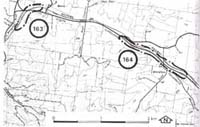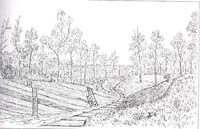163. Bena - Basaltic Dyke
|
This information has been developed from one or more of these publications:
|
Location: | Korumburra - 917478. Railway cutting beneath the South Gippsland Highway overpass at Bena. |  Basaltic dyke (A) intruding Mesozoic sediments, Bena. |
Access: | South Gippsland Highway. | |
Ownership: | Crown Land. | |
Geology: | A weathered basaltic dyke is exposed in the railway cutting immediately east of the road overpass. The material is coarse grained and may be dolerite or gabbro. The contact margins of the dyke with the Mesozoic sediments are clearly seen and these rocks are baked and partly silicified at this contact. The site was described and illustrated by James Stirling in 1891. | |
Significance: | Regional This is one of the largest and best displayed basic dykes in the study area. | |
Management: | Class 2. Artificial stabilising of the cutting should not be carried out as this would obscure the exposure. | |
References: | Stirling (1891). | |




